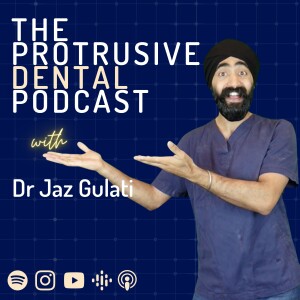
Building on from Basics of Occlusion Part 1, I am joined Dr Mahmoud Ibrahim who takes us on his journey from hating Dentistry to eventually loving occlusion and aesthetic Dentistry. We geek out over occlusal contacts, the occlusal examination and freedom in centric!
https://youtu.be/emfAS95VARU
Check out this full episode on YouTube
Need to Read it? Check out the Full Episode Transcript below!
Protrusive Dental Pearl: When you’re checking occlusion after placing your restoration, check on the contralateral side with the articulating paper (19 microns, for example) to see if it is 'passing through'. If it does pass through, double up the articulating paper (now 38 microns). You can keep doubling-up if you need to, until the paper holds. How does this help? You'll know right away if you need to adjust anything, and if so, you'll get a better idea of how much adjustment is likely.
“Keep everything nice and smooth, the patient has nothing to grab hold of and push against. That's probably going to make sure your restorations last a lot longer.” - Dr. Mahmoud Ibrahim
Jaz Edit to the above quote: By 'Smooth' we don't mean highly polished or glazed. We refer to the movements of the mandible being smooth, rather than jerky or abrupt.
3-minute Occlusal Examination PDF - Click here
In this episode, we talked about:
7:59 Mahmoud’s journey in Falling in love back to Dentistry13:16 Tripodized Contacts19:55 How to maximize cusp to fossa26:54 Bonus little trick on avoiding high restorations28:40 What do we check in a basic occlusal examination?38:15 Freedom from Centric/Freedom in Centric49:11 Relevance of the Centric Relation Contact Point56:41 Disadvantages of doing MIP vs Centric Relation Contact Point
Join us in our Telegram Community, where we can always help each other out!
If you loved this, be sure to watch the Part One of the Basics of Occlusion!
Click below for full episode transcript:
Opening Snippet: As the mandible is moving, everything should be smooth, and then also everything to be shallow. If you can do that, like you will dramatically reduce your rate of failures with the anterior restoration, just those two gems that you gave there...
Jaz's Introduction: Hello, I'm Jaz Gulati. And in this episode, we go one step further carrying on from basics of occlusion part one, right,? Thank you so much for the awesome feedback you guys gave for part one, and I'm so happy to have my brother from another mother cut from the same occlusal cloth, Mahmoud Ibrahim, who is a fantastic dentist, you see his work on Instagram. He is amazing. But just learning about a story from this episode is so, so great, because it's the first time we had a proper chat. I've been following him for a few years now. And I didn't realize that he hated dentistry when he qualified right? And I look at his work now. And I think whoa what happened so as well as so many clues or gems. So I'm going to give you a little preview of in a moment that we share with you. I love just him sharing his story with you of what happened, what was the spark that changed him from hating dentistry and actually trying to follow a career of making websites to then falling in love with Dentistry again in a big way. And they're really killing it at the whim as he is. Now, I hope you got your coffee ready because there's a lot of stuff that we're gonna cover in this very intense but very jam packed episode. Hope you like the analogies and stories and in cases that we discuss, we're trying to make it as friendly as possible for all my beloved listeners. The watchers is great to have you if you're on YouTube, hit subscribe. But for those who listen, you are the originals, I will always make sure that the content is easy for you to consume on your commutes. Right? So the kind of things that we cover is what is the difference between the so called tripodized contacts, and is it really better than cusp to fossa and how can we maximize stability w...
view more
More Episodes
IPR for Dummies – PDP045
 2020-10-31
2020-10-31
 2020-10-31
2020-10-31
Stay away from TMD! [SPLINTEMBER] – PDP039
 2020-09-16
2020-09-16
 2020-09-16
2020-09-16
012345678910111213141516171819
Create your
podcast in
minutes
- Full-featured podcast site
- Unlimited storage and bandwidth
- Comprehensive podcast stats
- Distribute to Apple Podcasts, Spotify, and more
- Make money with your podcast
It is Free
- Privacy Policy
- Cookie Policy
- Terms of Use
- Consent Preferences
- Copyright © 2015-2024 Podbean.com





